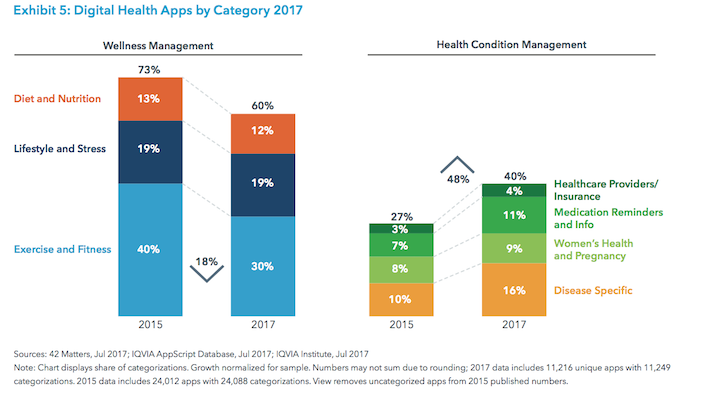Existing digital health products, if deployed comprehensively across the country, could save the US $7 billion a year in healthcare spending, according to a new report from IQVIA, which until yesterday was known as Quintiles/IMS Health.
“For the first time we’ve sought to create a model that looks across five different patient population groups where there’s been a proven reduction in acute care utilization, typically hospitalization, when consumer mobile apps are used,” Murray Aitken, executive director of the IQVIA Institute for Human Data Science, said in a conference call with press about the new report. “Diabetes prevention, diabetes care, asthma, cardiac rehabilitation, and pulmonary rehabilitation — in each of those five areas we took the results from published research and modeled that to estimate that if these available apps today were used by all patients who could benefit from them, the US healthcare system could save $7 billion per year. So that’s just for five areas. If that level of savings was achievable across all disease areas, we’re looking at annual savings of something like $46 billion.”
The report follows up on research that IMS Health published in 2013 and 2015, and IQVIA concludes that the market is much more mature than it was then.
“What we’re reporting in this edition is a significant growth in the impact that digital health is having on patients and healthcare, and a maturing of the environment to play a meaningful role in patient care,” Aitken said. “We’re seeing more innovation. Importantly we’re seeing more evidence of the impact that digital health can have on outcomes as well as cost. We’re seeing an increase in adoption of mobile health apps and we’re seeing acceleration in all of these areas. We report that there are now more than 318,500 consumer apps that are health-related available for download. That’s nearly double the number from two years ago. There’s about 200 new apps added to the marketplace each day.”
While general wellness apps still make up the majority of health apps, chronic condition management apps are catching up and now make up 40 percent of all health apps. Also, the app landscape is still top-heavy: just 41 apps make up half the downloads, with more than 10 million downloads each. Meanwhile, more than 85 percent of health apps have fewer than 5,000 installs.
“When we look across the full spectrum of apps that are now available, the apps seem to be getting better based on user experience, certainly compared to what we saw in 2015,” Aitken added. “We note in the report that 55 percent of apps in our database have user ratings higher than four stars; that compares to 31 percent of those launched in the two years prior to 2015.”
In addition to the apps themselves, the report looks at the growing amount of efficacy data available about these apps, based on searches on ClinicalTrials.gov. As of February, there were 869 active trials using digital health technology worldwide and 540 in the US.
IQVIA also notes that a lot of the barriers to adoption that they observed in 2013 and 2015 are starting to come down little by little, as more privacy and security guidelines have been published, app formularies are being established, and the shift to value-based care is continuing.
“We still have a long way to go,” Aitken said. “We don’t want to overstate the extent to which mobile health apps have become mainstream, but relative to four years ago there’s a lot of progress that has been made.”
https://www.mobihealthnews.com/content/report-todays-technology-digital-health-could-save-us-7-billion


